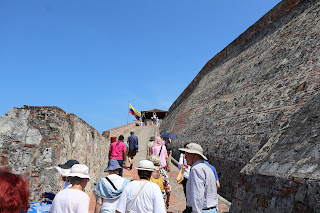Castillo San Felipe de Barajas, perched atop the Hill of San Lázaro in Cartagena, Colombia, is one of the most formidable examples of Spanish colonial military architecture in the Americas.
Originally constructed in 1657 and expanded over the following century, the fortress was designed to defend the city from both land and sea attacks. Its strategic location allowed it to dominate all approaches to Cartagena, making it a critical stronghold during colonial times. The fort was named in honor of King Philip IV of Spain and was built using African slave labor under Spanish supervision.
The structure is renowned for its complex system of tunnels, thick stone walls, and layered defenses. Its triangular design includes multiple batteries and parapets that protect one another, creating a nearly impenetrable defense system. During the 1741 Battle of Cartagena de Indias, the fort played a pivotal role in repelling a massive British invasion led by Admiral Edward Vernon. Despite being vastly outnumbered, the Spanish defenders, under Admiral Blas de Lezo, successfully held the fortress, marking one of the most significant military victories in colonial Latin America.
Today, Castillo San Felipe de Barajas is a major tourist attraction and a UNESCO World Heritage Site, recognized for its historical and architectural significance. Visitors can explore its eerie tunnels, climb its battlements for panoramic views of Cartagena, and learn about its storied past through guided tours and exhibits. The site is open daily and offers various ticket options, including discounts for students and free entry for children under six and seniors over 62.
The fortress is not only a symbol of Cartagena’s colonial legacy but also a testament to the city’s resilience and strategic importance in the Spanish Empire. Its imposing presence and rich history make it a must-visit for anyone interested in military history, colonial architecture, or the cultural heritage of Colombia.
|
The fortifications of San Lázaro |
|
«In 1741, the Castillo de San Felipe stopped the advance of Sir Edward Vernon and his army. After this defeat, the military engineer Antonio de Arévalo designed a plan to reinforce the fortification. Between 1762 and 1769, Arévalo almost completed his task, multiplying the defensive capacity of the old Castle by at least seven times.» «Arévalo is renowned for his originality in the design of complementary batteries and his ability to build them at astonishing speed. Also, in the detail and precision displayed in the plans of his project. He outlines the fundamental elements that gave the current form to the set of fortifications of the Cerro de San Lazaro.» |
|
«Unlike other constructions, the Castillo de San Felipe was built around the topography as if it were a lining made of stone, brick, and plaster. Hence, the oldest parts are at the top, and the newest ones are at the bottom. It grew top-bottom.»
|
|
Panorama of the San Felipe de Barajas Castle |
|
Going up the access ramp |
|
Hornabeque battery seen from the north |
|
Entering the Battery Tunnel |
|
Walking through the Battery Tunnel |
|
Leaving the Battery Tunnel |
|
Bonnet (Bonete) |
|
Entering the Perimetral Tunnel |
|
Traveling through the Perimetral Tunnel |
|
Leaving the Perimetral Tunnel |
|
Bonnet (Bonete) |
|
Convent of La Popa seen from San Felipe de Barajas Castle |
|
Leaving San Felipe de Barajas Castle |
See Also
-
Convent of La Popa
-
Cartagena
-
Zenu Gold Museum
-
Church of Santo Domingo
-
Cathedral of Saint Catherine of Alexandria
Source
Location



















